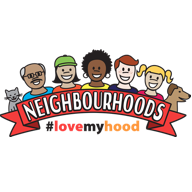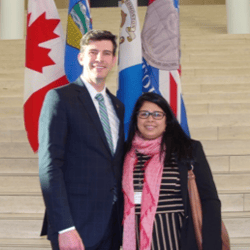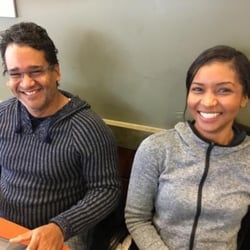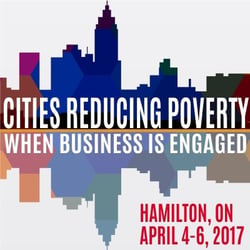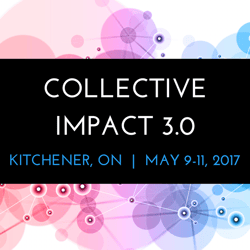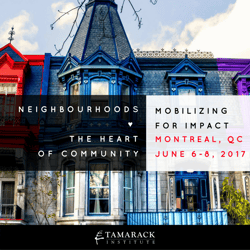Tamarack Institute | March Edition, 2017
In this Issue:
- Tamarack 2016: A Year of Progress & Impact
- Social Procurement: A Potential Lever in Poverty-Reduction?
- Connecting Lakeside: A Deepening Community Initiative
- Our Growing Understanding of Community Well-Being
- Connecting to a Cause: When Business Gives Back
- The Latest from the Field
- Upcoming Events You Won't Want to Miss
Tamarack 2016: A Year of Progress & Impact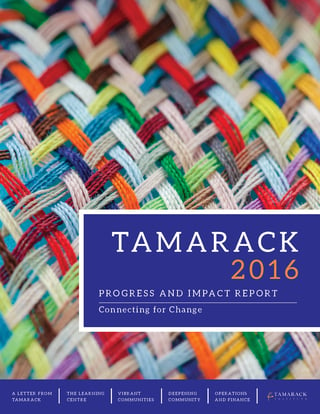
BY: TAMARACK
At Tamarack, our aim has always been to provide leaders with the knowledge and inspiration they need to achieve success in their community change efforts. By documenting, generating and disseminating knowledge, both in person and via a variety of channels, we strive to provide community change leaders with the resources and inspiration they need to make their work easier and more effective.
Our 2016 Progress and Impact Report has just been published and we’re happy to now share it with you. We also want to recognize and thank the many partners and supporters who have collaborated with us as, together, we support and grow as a connected force for community change. Our accomplishments in 2016 include:
- Providing more than 15,000 days of learning for community leaders and change-makers
- Hosting 8 multi-day events and 33 one-day events to equip and inspire people for impact
- Launching a new website featuring tools, resources, and Five Big Ideas for systems change
Thank you for the many ways in which you contributed to this momentum. Whether it has been through participating in one of our unique learning events, sharing resources, or profiling stories of community change in action in one of our practice areas – Vibrant Communities Canada and Deepening Community – we remain focused on supporting efforts to translate theory into practice.
In 2017, the work of creating engaged, inclusive communities is more important and urgent than ever. Responding to our learners’ evolving needs, Tamarack will introduce new event curriculum in 2017. We’ll ensure our website is where you can find the latest in community change. And, we’ll keep advancing understanding about collective impact and how to harness its value as fully as possible.
Join us in Kitchener, Ontario from May 9– 11, 2017 for the debut of our newest 3-day learning event. Collective Impact 3.0 will bring together experts, practitioners and early adopters to share their emerging practice, lessons learned, insights and challenges in collective impact. We hope to see you there!
Learn More:
- Download Tamarack's 2016 Progress and Impact Report
- Join us for the debut of Tamarack’s latest learning event: Collective Impact 3.0 from May 9 – 11, 2017 in Kitchener, Ontario.
- Download the event flyer for Tamarack’s new Collective Impact 3.0 Learning Event
- Learn more about the Tamarack Team
Share this article:
Social Procurement: A Potential Lever 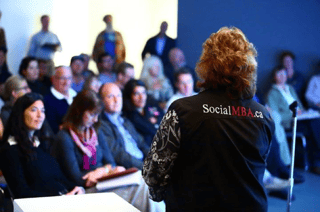 in Poverty-Reduction?
in Poverty-Reduction?
BY: SANDRA HAMILTON
In Alberta, a Social RFQ (request for quotes) issued last fall, was intentionally designed to provide work opportunities to previously homeless, recently housed individuals, who were workforce ready, but faced barriers to employment. This IS social procurement: an approach to better leverage taxpayer funded supply chains to move beyond ‘do no harm’ and start working proactively to ‘do some good.’ Social procurement works on the premise that taxpayer funded contracts should also enhance social value in our communities.
Last fall, the Regional Municipality of Wood Buffalo (RMWB) became the first municipality in Alberta to adopt social procurement. “We had started working together long before the 2016 wildfires” said Hamilton, but the evacuation of Fort McMurray in the spring caused an understandable delay in the RMWB council approving its social procurement framework. “This initiative is now more important than ever,” said RMWB Procurement Supervisor Laurie Gaudet, “Social procurement is about improving lives. People are a top priority of the recovery plan. It just makes so much sense to align our existing spending with the strategic priorities of recovery and of the community. My only question is: why have governments not been doing this for years?”
As a leading social procurement expert, I was recently nominated by the federal government to speak at the World Trade Organization (WTO) Symposium on Sustainable Government Procurement. I first learned about the concept while working as business manager to Vancouver 2010 Olympic Games CEO John Furlong. The Vancouver Olympics were the first Olympics in history to add social criteria to the sustainability strategy. For example, in addition to a price-competitive bid and the capability to deliver, the floral contract for the games also required a community benefit. The successful bidder committed to training women facing barriers to employment and living in the downtown eastside of Vancouver, to become florists throughout the course of the contract.
Social Value Infrastructure Pilot
I believe that Canada’s anticipated $180 billion investment in infrastructure, must also be an investment in people, especially, Canada’s most disadvantaged people. Consequently, I have developed an industry supported pilot that is working to develop a standardized approach to community benefit procurement across multiple governments. Believed to be the first of its kind in Canada, my pilot collaborators include the Vancouver Island Construction Association, the Construction Foundation of BC and the municipalities of Victoria, Qualicum Beach and Campbell River. Taxpayer-funded supply chains can, and should be, better leveraged to reduce poverty and improve the lives of Canadians.
Learn More:
- Visit Sandra Hamilton’s website for more on social procurement
- Read Advancing Social Procurement in Canada by Sandra Hamilton
- Read Social Innovation in Public Sector Procurement to learn about Cumberland B.C. – Canada’s first Buy Social Certified Municipality
- Join us at Cities Reducing Poverty: When Business is Engaged – April 4–6, 17, Hamilton, ON
Share this article:
Connecting Lakeside: A Deepening Community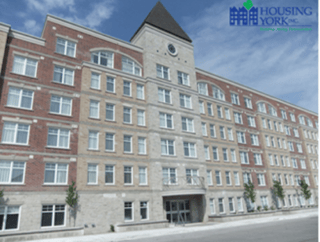 Initiative
Initiative
BY: HEATHER TILLOCK AND ERINN JAY
In the spring of 2016, The Regional Municipality of York partnered with Tamarack to launch a Local Deepening Community Initiative called Connecting Lakeside at its Lakeside Residences Building in South Keswick. The conversations hosted as part of the Connecting Lakeside Initiative helped neighbours get to know one another; discover their shared hopes for the building that they call home; and, discover the gifts, knowledge and talents they each have to share. It also created an opportunity for Region staff and community partners to get to know and work with Lakeside residents to facilitate linkages with the broader community, and to support resident-led projects that have made the building an even better place to live.
Connecting Lakeside engaged more than 60% of Lakeside building’s residents and has sparked the emergence of resident leadership from across the building. One shining example, is the formation of a monthly breakfast club. Not only does it help promote healthy eating, and connection that is FREE for everyone, financial contributions by participants have been collected and donated to a range of local charities including a $500 donation to the local Sutton Youth Shelter. As another example, two residents contributed the gift cards they won at the building’s Master Chef competition to host a free Thanksgiving Dinner potluck for all. A total of 31 residents – including 5 new faces – attended this event.
The Connecting Lakeside Initiative has been credited with contributing to a 28% increase in tenant engagement between 2015 and 2016 at Lakeside. This includes a significant increase in participation at Housing York led meetings and reflects the increased level of trust between the residents of the building and Housing York this project has fostered. The project has also generated other tangible benefits to Housing York. These include: a reduced call time in the building’s units; a reduction in neighbour-to-neighbour complaints; enhanced communication with residents; and a savings of cost and resources because of more resident-led initiatives in the building.
By initiating this project and connecting the residents of the Lakeside building in a positive way, the Connecting Lakeside Project has also led to the formation of two resident-led Action Groups to enable residents to work together on two community issues that were identified in the conversations. These are: A Resident Communications Group that is exploring ways to welcome new tenants to Lakeside and encourage neighbours to look out for each other; and, An Enhancing Accessibility Group that wants to explore opportunities to improve physical accessibility in the neighbourhood. More than 26 people attended the Enhanced Accessibility Group’s first meeting – including people from three neighbouring buildings – who share the same concern. The group’s next steps include hosting a meeting with their Mayor, local councillor, the Town’s Accessibility Committee and representatives of the BIA to brainstorm opportunities for collective action.
The Connecting Lakeside Deepening Community Initiative has created an opportunity for Region staff and community partners to get to know and work with the residents of Lakeside to facilitate linkages between building residents and the broader community, and to support resident-led projects that have made the building an even better place to live. It has also effectively demonstrated how positive changes can occur in a short period of time by investing in meaningful community engagement and creating partnerships between organizations and citizens. It has shown that the answers to many of our complex community issues are often best addressed locally with different sectors working together.
Learn More:
- View the Case Study & HIGHLIGHTS from York Region’s Connecting Lakeside Initiative
- Join us for Neighbourhoods ♥ The Heart of Community: Mobilizing for Impact, June 6-8, 2017 in Montréal, PQ
- Learn how your community can partner with Tamarack on a Local Deepening Community Initiative
- Visit Tamarack’s Deepening Community Practice Area to find more resources to strengthen neighbourhoods and engage citizens
Share this article:
Our Growing Understanding of Community 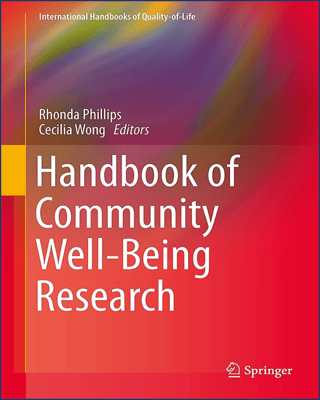 Well-Being
Well-Being
BY: SYLVIA CHEUY
What is community well-being and how is it improved? Those curious about this question will find much to engage them in the newly-published Handbook of Community Well-Being Research. It is the first publication of its kind to bring together foundational and leading-edge research to offer a compendium of knowledge, approaches and insights for improving quality of life in communities of place.
The Handbook features examples and thinking from around the world and a good number of contributions profiling work being done here in Canada including: a chapter by Derek Cook on the work of the Calgary Poverty Reduction Initiative; a chapter by Brian Smale and Margo Hillbrecht about the ground-breaking work of the Canadian Index of Wellbeing; and, a chapter that I co-authored with with L. Fawcett, K. Hutchinson and T. Robertson entitled, A Citizen-Led Approach to Enhancing Community Well-Being which outlines the journey of a diverse group of citizen leaders to create the first Headwaters Community Well-Being Report and then assess its subsequent impact.
I was the founding director of Headwaters Communities in Action (HCIA) – the citizen group responsible for creating the Headwaters Community Well-Being Report and Tamarack played a catalyst role in facilitating the initial meetings that led to its creation. Co-authoring the chapter gave me the opportunity to reflect on work I played a key role in. However, it was Tracey Robertson’s contribution to our chapter – outlining the funders’ perspective – that I learned the most from. Tracey was HCIA’s program manager with the Ontario Trillium Foundation (OTF), which was the anchor funder of the Headwaters Community Well-Being Report.
Reading more about the funders’ role as a strategic investor gave me a deeper appreciation of OTF’s willingness to take risks and innovate: choosing to invest in a citizen-led collaborative, though historically their investments were made only to organizations and municipalities. For more, read Tracey’s blog: Reflections on the Funders’ Role as a Strategic Investor in Community Change. OTF’s willingness to move beyond the role of a “traditional funder” in favour of a strategic investor role was something new for them and it was inspiring to discover that the learning and insights that OTF gleaned from its involvement with such innovative investments in comprehensive community-based initiatives, like the work of HCIA, contributed to its recognition of the need for a new investment stream: its recently debuted a Collective Impact Investment stream – which enables OTF to continue to be a catalyst and investor in system-wide community change.
Learn More:
- Learn more and order your own copy of The Handbook on Community Well-Being
- Read A Citizen-Led Approach to Enhancing Community Well-Being
- Check out Tracey Robertson’s blog: Reflections on the Funders’ Role as a Strategic Investor in Community Change
- Visit the Headwaters Communities in Action website
- Discover the Canadian Index of Wellbeing and its 2016 Ontario Regional Reports developed for the Ontario Trillium Foundation
Share this article:
Connecting to a Cause: When Business Gives Back
Back
BY: LISA ATTYGALLE
In 2015, Vidyard, a video marketing and analytics company based in Kitchener, Ontario, launched an initiative called PlugIn aimed at helping to mitigate some of the negative effects of gentrification in downtown Kitchener by giving back to their community.
The influx of tech companies, such as Google, NetSuite and start-ups such as Thalmic Labs, moving into Kitchener has had both positive and negative effects. New businesses are opening and the downtown is seeing a revival, but there is also the potential for impacts such as unaffordable housing and resulting displacement of people who can no longer afford to live there. Michael Litt, Co-Founder and CEO of Vidyard watched this happen in San Francisco and is actively fighting against this becoming a reality in Kitchener.
Litt knows that a vibrant city is a diverse city, so when Vidyard’s leadership team met to brainstorm ways of improving their company culture, they knew they had to help their 160 employees to understand what a vibrant city looks like, and the concept of PlugIn was born.
PlugIn is a win for the community, local business owners and Vidyard employees. On a monthly basis, Vidyard hosts fun and memorable events at a local business – such as a movie and games night or a party featuring micro brews and piano duels – to unite the area’s professionals; increase exposure to new local businesses; and, provide proceeds from ticket sales to a local charity. Vidyard also offers in-kind services to create a video for the charity to help raise the profile of its work.
This model for giving back is unique so I was grateful to have the opportunity to sit down with Litt to learn more about his tech company’s approach to community impact. What stood out to me was the creativity of the model, so I asked him to share some advice to other businesses who are looking to connect to a cause:
- Consider the Community as a Stakeholder – Vidyard wants to define their stakeholder value chain as: 1) Customers, 2) Vidyardians, 3) Community, and 4) Investors. When you list the community as a stakeholder, and especially when you consider the community’s needs to be more important than profit, you then have the opportunity to make decisions for the betterment of the community.
- If You’re Not in a Position to Commit Money to a Cause, Commit Resources Instead – Vidyard is a start-up and a venture-funded company where all expenditures are from capital, so they’re not yet in a position where they can commit straight-up money to a cause. Litt shared that, “If I went to my board and asked for a $15,000 donation to charity they would say you should invest that money into growing your business, so what we do is to commit employee resources instead.”
- Make it a Whole Team Commitment – When the community is a stakeholder you then have a platform to communicate with your team that community is important. Litt said that “If leadership is behind it, it gives permission to the people in the company to get behind it as well.” As a leader you can set the course, but it can be beneficial to share the responsibility and ownership of giving with your team. Consider connecting it with career progression by providing opportunities for employees to lead, to be entrepreneurial, to manage projects, to manage money, and get exposure.
Vidyard is also currently undertaking the 1:1:1 pledge as a model for corporate philanthropy that assigns one percent of employee time, one percentage of product and one percent of profit to non-profits in the community.
When Litt tells businesses that they need to get involved in the community and they respond saying they can’t afford it, he challenges them to give resources and employee time instead, “Then it’s not a question of money, it’s a question of time.”
LEARN MORE:
- Visit the PlugIn and Vidyard websites
- Join the Vidyard team
- Attend Cities Reducing Poverty: When Business is Engaged taking place April 4-6 in Hamilton, ON
Share this article:
BIG MOMENT FOR NEIGHBOURS IN KITCHENER, ON
By: Michelle Drake
Read the Post
RIGHT-SIZING YOUR ASK
By: Lisa Attygalle
Read the Post
CITIES REDUCING POVERTY: A CATALYST FOR COMMUNITY-LEVEL CHANGE
By: Leena Sharma
Read the Post
TELLING A NEIGHBOURHOOD RESILIENCY STORY BY READING THE DATA
By: Sheila Murray
Read the Post
GOING DEEPER: BUILDING OUR TRUST ACCOUNT
By: Liz Weaver
Read the Post
MANDATORY WINTER TIRES & POVERTY
By: Mark Holmgren
Read the Post
Cities Reducing Poverty: When Business is Engaged
April 4-6, 2017
Hamilton, ON
Ending poverty is everyone’s business. From April 4-6, 2017 we will share in the experience, thought leadership, and success stories to better understand how businesses large and small can be key leaders and contributors to local poverty reduction efforts.
The Cities Reducing Poverty summit will bring together major business leaders with community organizations; mayors and municipal staff; federal and provincial/territorial governments; Indigenous leaders; as well as funders, policy makers, and persons with lived experience to a common space where we will grow our ability to understand and embody true multi-sectoral collaboration to end poverty in Canada.
Learn more and Register Today.
Collective Impact 3.0
May 9-11, 2017
Kitchener, ON
Collective Impact 3.0 is a three-day intensive workshop for practitioners in early stage, mid stage and later stage community change work. The workshop will explore the latest in the practice of collective impact from experts, practitioners and early adopters of the work.
This workshop is best suited to those who have an interest and some basic knowledge and experience with collective impact and are eager to tackle the challenging but critical task of moving the needle on complex community challenges like poverty, homelessness, environmental change, early learning and active living.
Learn more about this brand new event.
Neighbourhoods ♥ The Heart of Community: Mobilizing for Impact
June 6-8, 2017
Montreal, QC
Neighbourhoods ♥ The Heart of Community: Mobilizing for Impact is a unique national learning event that brings together the most innovative and inspiring examples of neighbourhood action at its best and then invites us to accelerate our effectiveness by learning from one another and imagining how we can ensure our collective work has greater impact.
Participants at this event will be introduced to effective programs and resources that are successfully reconnecting neighbours, deepening community and advancing positive change on a range of complex issues.
Learn more and be the first to Register.
Deepening Community for Collective Impact
March 14, 2017
Abbotsford, BC
Join Paul Born for a one day workshop where you will learn how to engage and deepen your community in order to build a common agenda for large scale change. Paul will share not only the fundamental principles of Collective Impact, he will provide key insights as one of North America’s top Community Engagement leaders on how Deepening Community can sustain us as leaders and produce the outcomes we so desire.
Accelerating Community Change with Collective Impact
March 15, 2017
Regina, SK
Join internationally recognized trainer and community builder, Liz Weaver, for a one day workshop that dives into the collective impact approach and how you can use it to enhance the impact of community change efforts.
Webinars
Can’t make it? Don’t fret.
By registering you will also receive a recording of the live session along with related resources.
Just Change: How to Collaborate for Lasting Impact
Guest: Tynesia Boyea-Robinson, Living Cities, Chief Impact Officer
Date: March 29, 2017 | 1:00 - 2:00 p.m. EST *NEW DATE*
Collective Impact: Lessons from the Field
Guests: Mary Pickering, The Atomspheric Fund; Elena DiBattista, Our Kids Network, Halton; Donna Gates, Living SJ
Date: April 13, 2017 | 12:00 - 1:00 p.m. EST
Collaboration not CoBLABoration: A Conversation with Chris Thompson
Guest: Chris Thompson, Civic Collaboration Consultants LLC
Date: April 18, 2017 | 12:00 - 1:00 p.m. EST
You don’t need to be afraid anymore! How to authentically engage the community while remaining in control
Guest: Matt Crozier, Co-Founder & CEO, Bang The Table
Date: May 17, 2017 | 1:00 - 2:00 p.m. EST

